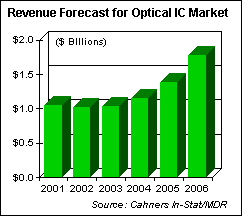In-Stat/MDR Report predicts that the optical IC market will grow to $1.8 billion by 2006
March 7, 2002

Good times might not be upon us quite yet, but if you’re an integrated circuit (IC) vendor, they’re coming. This is the message of a recent Cahners In-Stat Group/MDR report that predicts that the optical IC market will reach $1.8 billion by 2006.
The report, which was released on Monday, anticipates that optical networking and its supporting equipment components and ICs should start picking up towards the end of this year. Today the market brings in revenues of just over $1 billion. Between 2001 and 2006, the compound annual growth rate (CAGR) for the overall market will be about 11 percent, according to the report.
|
|
|
"It will grow steadily," says Eric Mantion, a senior networking technology analyst with In-Stat, and the author of the report. “Not in leaps and bounds. It’s a mature market.”
The increasing demand for high-speed capacity within the core of the public network, along with a geometric growth of the Internet, private IP networks, and business-to-business (B2B) e-commerce is what’s expected to drive the surge in IC revenues, according to the report. The market research company foresees optical networking as the norm for all but the last mile, and some proponents even feel that fiber will enter the last mile more extensively.
The steady climb in revenues seems, however, to have skipped 2002. Optical ICs are in a bit of a slump, which Mantion expects will reach its low point in the second quarter this year. The slowdown is due to the combined effects of lower demand, the semiconductor ASP decline, and a reduction in lead time before products are needed.
"People got burned by over-forecasting,” Mantion says. “Now [they] are waiting a little longer. [They still] have a lot of [leftover] inventory to burn through.”
The market turnaround should come towards the end of 2002, Mantion says, and 2003 is expected to see 3 percent growth in IC revenues compared to 2002.
IC vendors will benefit from the fact that so many of the industry’s advances rely on semiconductor technology, according to Mantion. As new networks are built and existing ones upgraded, they will have the opportunity to penetrate the yet untapped access and enterprise markets.
While all segments of the market are expected to grow, the report reveals that 10-Gbit/s Ethernet should experience a phenomenal growth rate. Short-range OC192’s growth rate will be quite healthy as well, although this is also the area that will see the greatest price erosion by the end of the forecast period, Mantion says. Long haul will continue to increase at the same slow, steady pace it is already demonstrating.
“There is thirst and hunger in the MAN for 10 Gig,” Mantion says, pointing out that while there is already plenty of capacity in long haul, MANs have a lot of growth potential. “There’s a drought going on there, with floods on both sides.”
The 10-Gbit/s Ethernet market is growing fastest, Mantion says, because it is better than Sonet for data, and data is growing faster than voice. Another reason this area is growing so quickly is that it didn’t exist in 2001. When you start with zero, the numbers are obviously going to seem really big, he says.
Major players in the optical IC sector include:
Agere Systems (NYSE: AGR)
Agilent Technologies Inc. (NYSE: A)
Applied Micro Circuits Corp. (AMCC) (Nasdaq: AMCC)
Broadcom Corp. (Nasdaq: BRCM)
Cypress Semiconductor Corp. (NYSE: CY)
Infineon Technologies AG (NYSE/Frankfurt: IFX)
Intel Corp. (Nasdaq: INTC)
Mindspeed Technologies
PMC-Sierra Inc. (Nasdaq: PMCS)
Velio Communications Inc.
Vitesse Semiconductor Corp. (Nasdaq: VTSS)
As the current production-grade ICs are completed, they will be sold into two major end-user markets, according to the report: module suppliers and communication equipment vendors. Of the two, Mantion says he expects modules to be the most likely long-term winner.
— Eugénie Larson, Reporter, Light Reading
http://www.lightreading.com
You May Also Like











